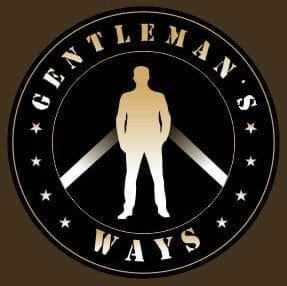Last updated on November 25th, 2025 at 07:11 am
A well-tailored men’s suit is more than just an outfit. It’s a symbol of fashion etiquette, refinement, confidence, and timeless style.
The right suit makes a powerful statement, whether you’re dressing for a formal occasion, a business meeting, or simply upping your everyday look.
From classic cuts to modern designs, there are many options available.
In this guide, we’ll not leave any stone unturned on everything you need to know about men’s suits, from selecting the perfect fit and fabric to understanding suit etiquette and modern trends.
The men’s suit serves as a central element in formalwear, laying a foundation for personal style and confidence.
As one of the foremost elements in groom’s wedding preparation, suits are referred as a masculine marker of the modern man.
A well-tailored suit can accentuate appearance, making a strong statement in any setting.
The selection of the right suit is sacrosanct, as it can influence how you present yourself and are addressed.
Factors such as fit, fabric, color, and overall design contribute to the suit’s effectiveness in reflecting your character and taste.
Recommended: Types of Men’s Shoes
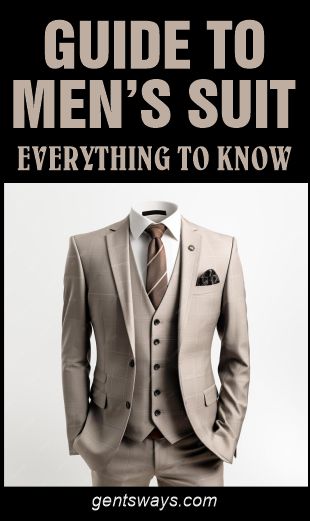
Table of Contents
- Key Takeaways
- History and Evolution of the Men’s Suit
- Types of Men’s Suits
- Suit Fabrics and Materials
- Suit Colors and Patterns
- Understanding Suit Structure
- Tailoring and Fit of Men’s Suits
- Seasonal Suiting: Suits for Every Weather
- Men’s Suit Etiquette and Style Rules
- Modern Trends in Men’s Suits
- Care and Maintenance of Your Suit
- Conclusion
Key Takeaways
- A well-tailored men’s suit is a symbol of refinement and confidence, expressing personal style for various formal and business occasions.
- Understanding the history of men’s suits helps us appreciate their evolution from functional garments to essential components of modern men’s wardrobes.
- Familiarity with different suit types: single-breasted, double-breasted, and three-piece, enables men to make informed choices that reflect personal style.
- Suit fabrics, including wool, linen, and velvet, offer different advantages, allowing for flexibility in style and comfort across seasons.
- Tailoring influences a suit’s fit and appearance, emphasizing the importance of adjustments like sleeve shortening and trouser tapering.
Recommended: What is Capsule Wardrobe for Men?
History and Evolution of the Men’s Suit
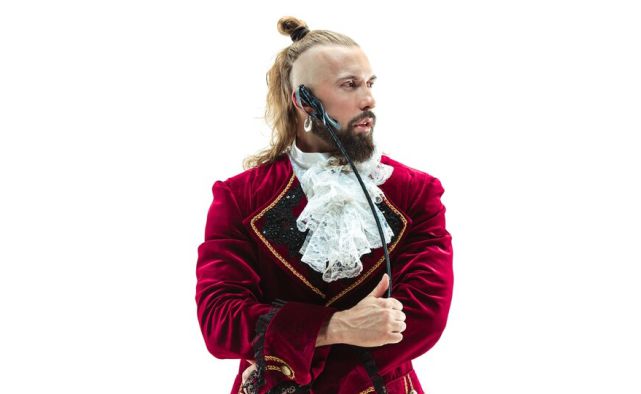
Since this post is going to be a comprehensive one, it’s good to make a brief flashback to the origin of suits and how it has evolved in the modern day.
Throughout history, the suit has evolved from being merely functional to becoming an indispensable part of a man’s wardrobe.
The origins of the modern men’s suit can be traced back to the early 17th century, emerging as a fusion of various historical garments.
One of the initial influences was the doublet, a fitted garment worn beneath the coat, which outlined the male form while providing warmth.
As fashion evolved, the coat became a fundamental part of men’s clothing, characterized by its long-cut and embellished designs.
By the late 17th century, the suit began to take its recognizable shape, with the introduction of the three-piece suit: trousers, a waistcoat, and a coat.
Recommended: Men’s Denim Jackets: History and Types
The 18th century saw a further evolution, driven by tailoring techniques that expressed craftsmanship and fit.
During this period, the French Revolution was a catalyst in shaping men’s attire, as simpler styles emerged to reflect the changing social dynamics.
This shift led to the creation of the frock coat, which became synonymous with professionalism and respectability.
The Industrial Revolution further impacted suit manufacturing, allowing for more standardized sizes and designs, which made sturdy and tailored suits accessible to a broader audience.
Related Posts
Dress Watch Guide for Gentlemen
Blazer Jackets for Men: Types and Care Tips
Understanding Men’s Blazer Size Chart
Blazers vs Sport Coat vs Suit Jacket
Types of Men’s Suits
Men’s suits are of various types, and being familiar with them is required of any gentleman in society to make informed choices that suit your style.
Among the most recognizable styles are the single-breasted and double-breasted suits.
Single-breasted Suit Style

The single-breasted suit is the most popular among men’s suits. It has a single column of buttons and a straightforward design.
This suit is designed to be sleek and forms a silhouette, making it a preferred choice for both formal events and business settings.
The single-breasted style features two or three buttons and can come with various lapel styles, such as notch or peak lapels, which we are going to talk about below, adding further customization for the wearer.
Double-breasted Suit Style
In contrast, the double-breasted men’s suit exudes a more official and traditional look, as you can see in the second photo above.
Characterized by its overlapping front and two rows of buttons, this style creates a broader chest appearance, which can improve the body’s proportions.
While generally considered more formal, a double-breasted suit can also be adapted for semi-formal occasions, depending on the fabric and color chosen.
This suit is particularly popular among businessmen and those in the fashion industry seeking to convey authority and refinement.
Related: How a Suit Jacket Differs from a Blazer
The Two-piece Suit
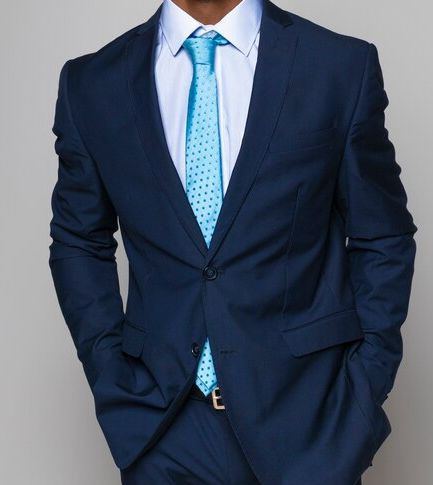
A two-piece suit is made of a matching jacket and trousers from the same fabric. It’s one of the most common men’s suits and is often worn for formal occasions like business meetings, weddings, and events.
The two-piece suit offers a sleek, polished look without the added waistcoat found in a three-piece suit, which we will discuss shortly.
It can be styled in classic, slim, or modern, depending on personal preference and the occasion.
A well-fitted two-piece suit is flexible and can be dressed up or down with different shirts, ties, and accessories.
Related: Fashion Accessories Every Man Should Have
The Three-piece Suit
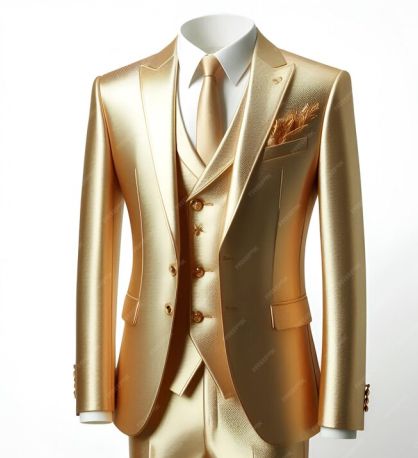
A three-piece suit is a two-piece suit with a waistcoat, also called a vest. The formal outfit includes a jacket, trousers, and the matching waistcoat vest all made from the same fabric.
The addition of the waistcoat sets the three-piece suit apart from a standard two-piece suit, offering an extra layer of refinement and formality.
Recommended: Introduction to Tie Etiquette
Suit Fabrics and Materials
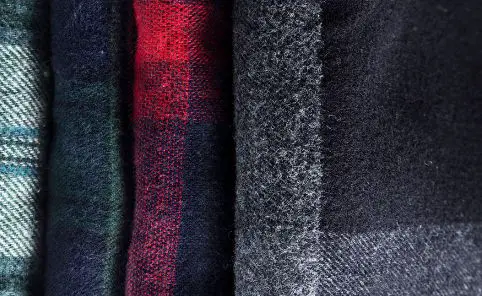
When it comes to selecting the right fabric for a men’s suit, the options available each have their pros, catering to various occasions and choices.
Wool
The most popular fabric is wool, which stands out for its durability. Wool for suits comes in different weights and weaves and can be used for both formal and casual suits, making it a go-to choice across seasons.
Wool fabrics also possess natural breathability and moisture-wicking properties, ensuring comfort throughout the day.
Linen
Linen is another suiting material that is suitable for warmer climates. Its most obvious characteristic is its lightweight.
But linen is susceptible to wrinkling and so should be considered for formal setting occasions.
Velvet
Velvet is a luxurious suiting material known for its soft, plush texture and subtle sheen.
Typically made from silk, cotton, or synthetic fibers, it offers that look ideal for formal occasions, such as black-tie events.
Velvet suits provide a rich, elegant appearance and are commonly used for dinner jackets or statement pieces in colder seasons.
Tweed
Tweed is a durable, woolen-suiting material that is rugged and has earthy, muted tones.
Originally from Scotland and Ireland, tweed is woven in various patterns like herringbone, check, and plain weave.
Its thickness and warmth make it ideal for colder weather, offering both style and practicality.
Tweed suits are often associated with classic, country-inspired looks and are perfect for casual or semi-formal occasions, exuding a timeless, heritage appeal.
Blended Suit Materials
Moreover, the rise of blended fabrics has gained traction in modern suiting. These fabrics combine elements of comfort, durability, and affordability by mixing natural and synthetic fibers.
Common blends include wool-polyester and cotton-spandex, which address the demand for versatile suits that maintain a polished look while being practical for everyday wear.
Suggested: Fashion Tips for Older Men
Suit Colors and Patterns
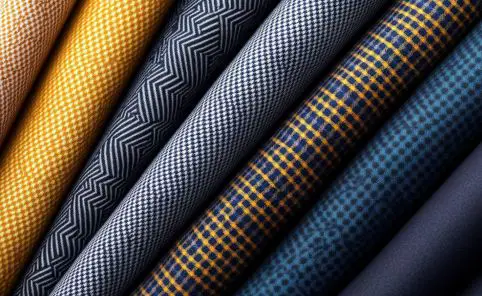
Colors are part of suit selection in men’s suits because they define the overall look and appropriateness for different occasions.
Navy, black, and charcoal are classic colors that you will never go wrong with for formal attire.
Navy Suits: A navy suit is mostly suitable for business settings and social events.
Black Suits: The black suit is traditionally for formal occasions, including weddings, galas, and the like.
Charcoal Suits: A charcoal suit is a dark gray suit that is ideal for formal, business, or evening events. Its neutral tone makes it easy to pair with different types of shirt and tie combinations. The charcoal color strikes a balance between black and lighter grays, offering a modern, sleek look while maintaining timeless elegance and adaptability across settings.
Gray Suits: Gray suits, whether light or dark, can transition seamlessly from day to night, making them a favored option for business meetings and evening gatherings alike.
Brown Suits: Brown suits provide a fresh aesthetic, ideal for casual settings or fall events. When selecting a shade of brown, it is good to consider the context, as darker browns may be preferable for business situations, whereas lighter hues can lend themselves well to outdoor functions.
Bright Color Suits: For those willing to make a bolder statement, suits in vibrant colors such as burgundy, green, and blue can, of course, add life to a wardrobe. Vibrant choices serve not only as eye-catching alternatives but also as reflections of personal style. Pairing such suits with neutral accessories can maintain a balanced overall look while allowing the suit to stand out.
Patterned Suits: Adding patterns to men’s suits can add a unique touch without sacrificing elegance. Pinstripes, plaids, and checks introduce personality to a suit while remaining within the bounds of traditional sophistication.
Recommended: Men’s Blazer Outfit and Styling Ideas
Understanding Suit Structure
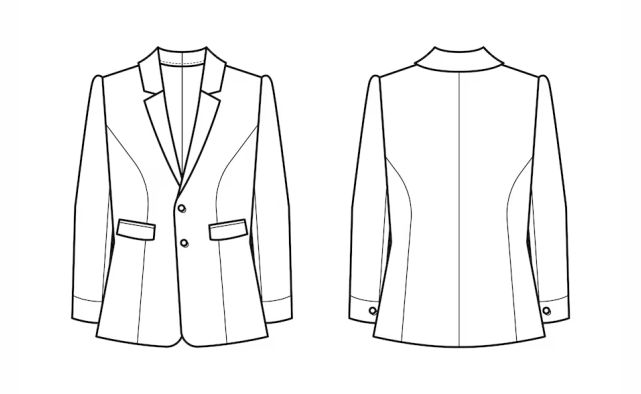
The structure of a suit jacket is an interesting one because of its appearance and functionality.
Key components such as lapels, vents, and lining determine the overall style and comfort of the garment.
Let’s take a closer look:
Lapels

Lapels are one of the most recognizable features of a suit jacket, and they come in three primary styles:
- Notch
- Peak, and
- Shawl
Notch Lapels: Notch lapels, characterized by their angular cut, are commonly found in more casual suits, making them suitable for business settings or social events.
Peak Lapels: Peak lapels, which feature pointed edges, are considered more formal and are frequently seen on dinner jackets and blazers.
Shawl Lapels: Shawl lapels, with their rounded edges, are favored for evening wear, particularly in tuxedos.
Each lapel style conveys a different sense of formality and is suited for specific occasions.
Vents
Vents are another important structural element, found at the back of the jacket. There are three main types of vents:
- Single vent
- Double vent, and
- No vent
Single Vent: A single vent allows for ease of movement and is often found in American-style suits.
Double Vent: The double vent provides additional space for fluidity and is favored in European tailoring.
No Vent: No vent jackets offer a cleaner silhouette, typically suited for more structured contexts.
The choice of the vent can significantly influence how well the jacket drapes and fits the wearer during movement.
Suit Trousers
When examining trousers, the distinction between flat-front and pleated styles becomes important.
Flat-front trousers provide a streamlined look and tend to be more modern, whereas pleated trousers offer additional room and can accommodate various body types.
The trends in trouser breaks, whether full, half, or no break, contribute to the suit’s overall visual appeal.
Additionally, the choice of lining within a jacket can either be half-lined or fully lined.
A half-lined option promotes breathability and is favorable for warmer climates, while a full-lined jacket may provide extra structure and warmth, catering to cooler environments.
Related: Men’s Fashion Style and Expression
Tailoring and Fit of Men’s Suits

The fit of a suit can affect the visual appearance and the comfort of the wearer.
A well-tailored suit can uplift an ordinary outfit into something extraordinary, making tailoring an important part of men’s fashion.
Key tailoring terminology helps in understanding how the different elements of a suit contribute to its fit.
Let’s examine the suit terms:
Break
The term ‘break’ refers to how the fabric of the trousers breaks on the shoe.
A classic break creates a clean line, while a break offers a more modern visual appeal. The amount of break can influence how polished the overall appearance is.
Waist Suppression
Another concept is waist suppression, which pertains to the tailoring of the waistline of the jacket. Reinforced waist suppression creates a more tailored silhouette, accentuating the body’s natural shape.
Shoulder Padding
Shoulder padding contributes to the suit’s structure, affecting how formal or casual the outfit appears.
The choice of shoulder padding can lead to a variety of looks, including soft styles that offer comfort and mobility to more exaggerated styles that provide a classic and authoritative stance.
Adjustment Techniques of Men’s Suits
Common adjustment techniques are worthy of mention as they help to achieve a perfect fit.
Shortening Sleeves: Shortening suit sleeves involves adjusting the length to ensure a proper fit, allowing shirt cuffs to show slightly for a polished, tailored appearance and comfort.
Tapering Trousers: Tapering trousers narrow the leg openings to create a more tailored silhouette, enhancing the overall fit and modern appearance of a suit for a polished look.
Made-to-measure, Off-the-rack and Bespoke Suits
It is also important to understand the difference between made-to-measure, bespoke, and off-the-rack suits.
Off-the-rack suits are ready-to-wear options that may require adjustments; made-to-measure suits are customized based on specific measurements but still follow existing patterns; bespoke suits represent the pinnacle of tailoring, crafted entirely to individual specifications.
Recommended: How to Tuck in Your Shirt
Seasonal Suiting: Suits for Every Weather
Selecting the appropriate suit for various seasons is necessary for both comfort and style.
Suits for Warmer Months
Material: For the warmer months of spring and summer, lightweight fabrics such as linen and cotton are highly recommended. These materials are breathable, ensuring that the wearer remains cool even in sweltering temperatures.
Color: Color selection also plays a significant role during this time. Lighter shades like pastels or muted colors are not only season-appropriate but also enhance the overall freshness of the look.
Pattern: Patterns such as stripes or checks can add an element of visual interest without being overwhelming.
Suits for Fall and Winter
Material: As temperatures begin to drop in the fall and winter, it becomes essential to transition towards heavier materials. Wool suits, known for their insulation properties, are ideal for keeping warm while also exuding elegance.
Colors: Darker colors, like deep navy or charcoal grey, are typically favored during this time as they complement the season’s aesthetic and maintain a professional appearance.
Layering: Layering is another vital technique in colder months. Incorporating items such as vests or tailored overcoats can enhance insulation without sacrificing style.
Transitional Suits
Transitional suits are an excellent investment for those looking to comfortably navigate between seasons.
These suits often utilize blended fabrics that balance breathability with warmth, making them flexible enough for a variety of weather conditions.
They may feature adjustable elements, such as removable linings, granting flexibility in styling.
Related: Corporate Fashion for Older Men
Men’s Suit Etiquette and Style Rules
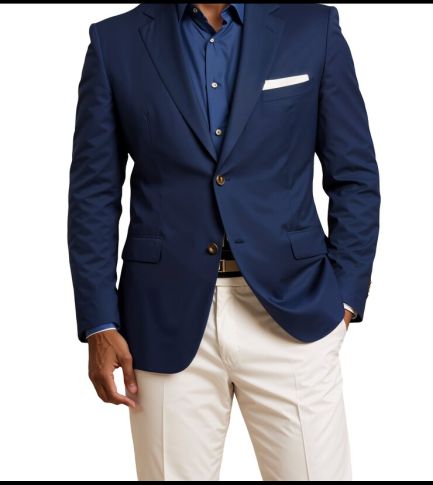
Understanding the etiquette surrounding men’s suits should be a priority for every man to ensure appropriateness in various social contexts.
Men’s Suit Buttoning Rules
To begin with, buttoning rules are a basic aspect of suit etiquette. The rule of thumb is to button up the jacket when standing and to unbutton it while sitting.
If the suit has two buttons, the top one should be secured, whereas, with three buttons, the middle button is generally buttoned. These small details contribute to a polished appearance.
Suits for Specific Occasions
When selecting a suit for specific occasions, the level of formality can greatly influence your choice.
Weddings
Weddings: For weddings, a classic tuxedo may be more suitable, particularly during evening events. Alternatively, a lighter-colored suit can be appropriate for day ceremonies, aligned with the seasons.
Business: In a business environment, opting for darker shades like navy or charcoal enhances professionalism.
Cocktail Events: When attending cocktail events, you might explore mixing fabrics, such as a wool blazer with cotton trousers, to balance formality with a contemporary touch.
Suit Fit
It is also important to consider the fit of the suit. A well-fitted suit should contour the body without being overly tight or baggy.
Emphasizing tailored suits not only accentuates the physique but also aligns with timeless style principles.
While current trends may introduce variations such as slim-fit or relaxed silhouettes, it is notable to harmonize these styles with classic elements like lapel widths and jacket lengths for a sophisticated look.
This is particularly relevant in maintaining a sharp appearance while adapting to modern aesthetics.
Related: Men’s Belt: Everything to Know
Modern Trends in Men’s Suits
Bold Colors and Statement Pieces
The modern trend in men’s suits has transformed, with bold colors beyond traditional black, navy, or grey.
Suits now feature vibrant hues like emerald green, deep burgundy, and pastel shades.
These choices allow men to express their style and make a striking impression in professional and social settings.
Adding unique patterns, such as checks or florals, adds flair to formal attire.
Mixing and Matching
The trend of mixing and matching suit pieces has also gained popularity, showcasing how flexible suits can be.
Pairing tailored blazers with contrasting trousers creates a refined yet relaxed look, suitable for office settings and social events.
This approach allows for various combinations of textures and colors, such as linen blazers with wool trousers or khaki suits with crisp white shirts.
The mix-and-match trend emphasizes creativity while adhering to formal dress codes.
Sustainable Fashion
Another noteworthy development is the rise of sustainable fashion in men’s suits.
Designers are increasingly using eco-friendly materials, offering suits made from organic cotton, recycled polyester, and sustainable wool.
These environmentally conscious garments provide the same level of luxury and style as traditional suits.
Athleisure-Inspired Suits
Athleisure-inspired suits are blurring the lines between casual and formal wear, incorporating comfortable fabrics and relaxed cuts without sacrificing elegance.
This fusion of casual comfort and formal aesthetics caters to the contemporary man’s lifestyle, providing options that seamlessly transition from work to leisure.
Care and Maintenance of Your Suit
Proper Storage
Caring for men’s suits begins with proper storage. Hang suits on sturdy, wide-shouldered wooden or padded hangers to maintain shape and reduce stretching.
When not in use, store the suit in a breathable garment bag to protect it from dust and allow air circulation.
Cleaning
Cleaning is vital for maintenance. Dry clean your suit sparingly, every four to six months, unless specific stains require immediate attention.
In between dry cleaning, use a fabric spray designed for garments to neutralize odors without strong scents, keeping the suit fresh.
Addressing Wrinkles
Regular upkeep includes addressing wrinkles and creases. A handheld steamer is ideal for quick touch-ups, as it relaxes fibers safely.
For deep wrinkles, hang the suit in a steamy bathroom. If using an iron, set it on low heat and place a cloth between the iron and fabric to prevent burns.
Common Repairs
Performing common repairs at home can extend your suit’s life. Sew loose buttons back on and make minor hem alterations with a needle and thread.
Address fraying seams or small tears promptly to avoid more extensive damage.
Conclusion
A high-quality, well-fitted suit should be on the frontline in a man’s wardrobe, reflecting style and professionalism for various occasions, from business meetings to formal events.
Investing in a suit increases confidence and presence, offering a polished appearance.
Key characteristics in men’s suits include fabric quality, craftsmanship, and fit, which determine the suit’s value and longevity.
Wearing a suit conveys respect and authority, pointing to attention to detail.
A well-crafted suit is a worthy investment in self-presentation and personal branding, reflecting respect for oneself.
References:
- https://www.andrew-brookes.com/blog/business-suit-guide/
- https://www.menswearr.com/blogs/fashion-guides/10-things-you-need-to-know-before-buying-mens-suit?
- https://www.menswearr.com/blogs/fashion-guides/10-things-you-need-to-know-before-buying-mens-suit?
- https://www.suitsexpert.com/men-suits-guide/
Pyo Merez is a men’s lifestyle enthusiast and writer about the gentleman’s place and impact on society. Raised by a distinguished gentleman dad, he offers unique insights into how the mind of a gentleman works and how societal norms shape gentlemen’s identity and vice versa.
Through his insightful articles, Pyo taps into the depths of gentleman culture to provide perspectives on etiquette and manners in modern society.
